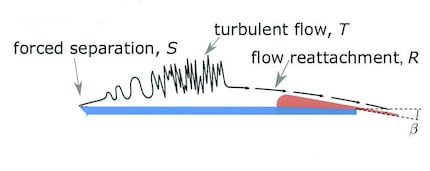
Guide
5G will disrupt weather forecasts worldwide
by Spektrum der Wissenschaft

Up to six times longer in the air and even more stable. For the design of new mini wings, researchers have simply thrown proven knowledge overboard.
A team of scientists has designed wings that would leave any normal passenger aircraft on the ground like a stone. Instead of guiding the airflow over the surface as gently and uninterruptedly as possible, they allow it to break off at the pointed leading edge of the wing. Surprisingly, as the team writes in the scientific journal Science Robotics, this ultimately leads to a more energy-efficient and stable flight.
However, this only works with wings that are well under one metre in size, i.e. so-called micro UAVs or micro drones. According to the team led by Matteo Di Luca from Brown University in Providence, Rhode Island, current batteries keep the aircraft, which weigh just a few grams, in the air for around half an hour. Thanks to their new wings, such an aircraft could fly for up to three hours, at least in an ideal scenario. Under realistic conditions, the flight time would still drop to a considerable one and a half hours or more, the group estimates based on their wind tunnel tests.

The structure of the wings was modelled on nature. Insects and other small fliers inspired them to disregard the laws of aerodynamics that apply on a large scale. Because in the world of the small, completely different influences would affect an aeroplane. For example, they would be constantly tossed around by gusts of air that would not affect a normal-sized aircraft.
The trick with the controlled stall, however, prevents the susceptibility to interference, the scientists found. Specifically, the pointed leading edge ensures that turbulence occurs in the front half of the wing. This appears to make the aircraft less susceptible to random gusts. At the rear end of the wing, the scientists attached a rounded rail similar to a landing flap. It catches the swirling airflow again and thus provides lift.
However, the trick reduces the efficiency of the wing, the researchers write. Which is why the wings have to be longer than those of conventional mini-drones. Dispensing with the classic wing profile also makes this easier: The wings could easily be thicker and correspondingly more stable, and more space would also be gained for batteries - and therefore an even longer flight duration.
We are a partner of Spektrum der Wissenschaft and want to make scientifically sound information more accessible. Do you like the articles from Spektrum? Then follow Spektrum der Wissenschaft or subscribe to the magazine and support scientific journalism.
, Photo: Richard Watt/MODExperts from science and research report on the latest findings in their fields – competent, authentic and comprehensible.
Practical solutions for everyday problems with technology, household hacks and much more.
Show all